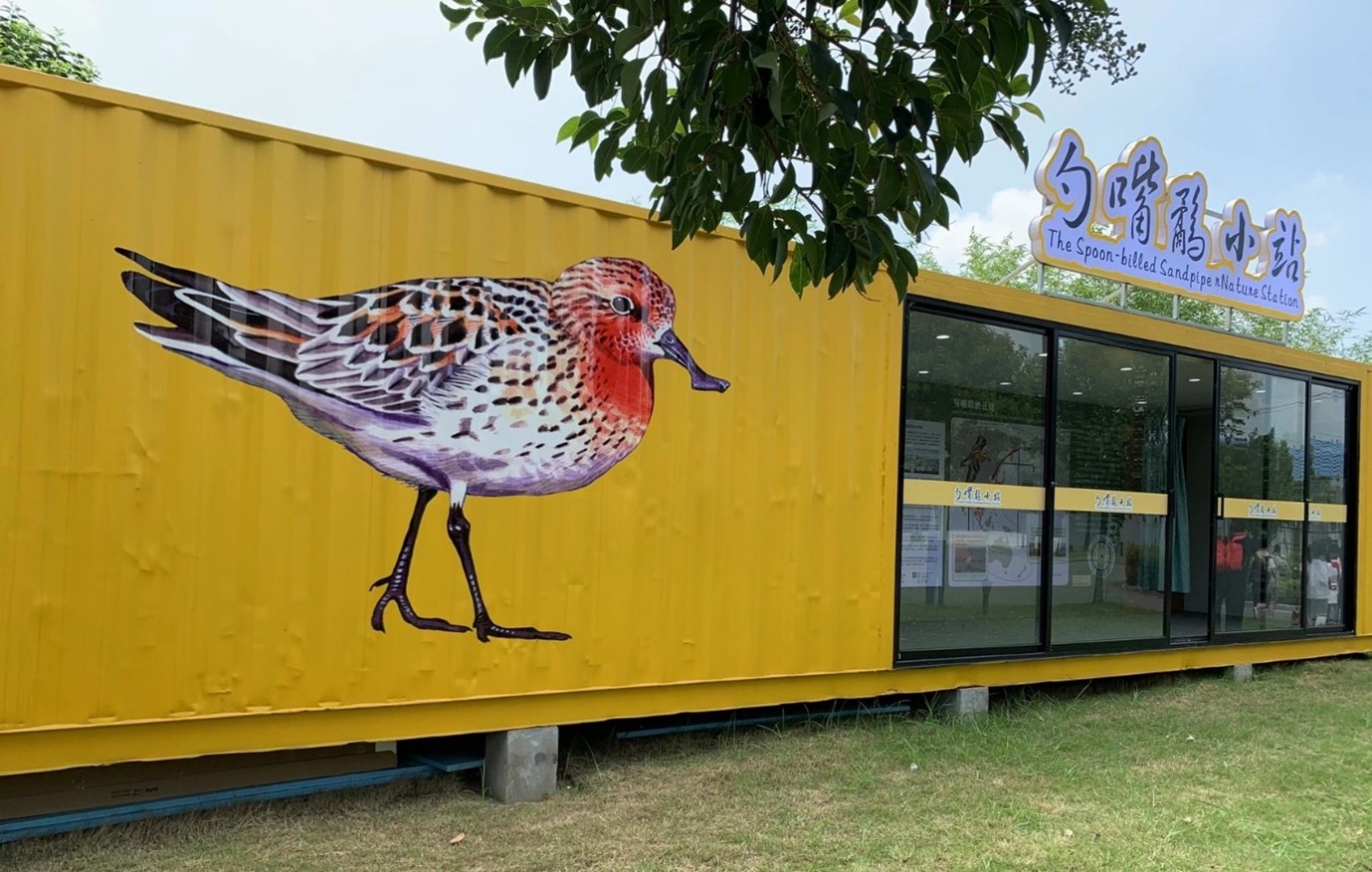If you are aware of conservation work for Spoon-billed Sandpiper, you may have heard about Spoon-billed Sandpiper in China (SBSinChina), a local NGO aiming to protect this Critically Endangered species in our Flyway. This time for the EAAFP Flyway story, we interviewed, Ms. Jing Li, Co-founder of Spoon-billed Sandpiper in China, she is also a member of the EAAFP Spoon-billed Sandpiper Task Force.
In 2006, Li Jing started working as a volunteer for the China Coastal Waterbird Census Group, she and the team began the work in Shanghai, where they carried on a monthly waterbird survey. Then they expanded the survey region to an adjacent mudflat on the Jiangsu coast in 2008. Now, Jing and the team has become one of the best-skilled conservation teams in China.

Jing Li with a banner of SBSinChina ⓒ SBSinChina
EAAFP: Hi Jing Li, you are well-known among the conservationists about Spoon-billed Sandpiper. To our wider audience, could you introduce yourself and briefly tell us about your present work, please?
I have lived in Shanghai since 2005, and my very first visit to Yangkou mudflat for Spoon-billed Sandpiper was in 2008. The team agreed that we should do something for this cute little bird. I am originally from Jiangsu. This was another personal reason that pushed me to make a career change.
Now we are monitoring seven important coastal wetlands in Jiangsu, which are in Lianyungang, Yancheng, and Nantong City. (A total of 1037 km of coastline in Jiangsu). As you may know, the team, SBSinChina, focuses on the conservation of the Spoon-billed Sandpiper. Besides, there are many other globally threatened species, e.g. Nordmann’s Greenshank, Asian Dowitcher, Oystercatcher, and Far Eastern Curlew in Jiangsu. We are trying to understand how they use the habitats in Jiangsu and provide more evidence to support flyway-wide conservation programs. The regular waterbird survey accounts for 50% of our work, the other 50% of the time, we initiate programs to raise awareness in local communities and working with the local and higher-level government departments for better conservation policy.
EAAFP: We learned that you started your career in a different field from nature conservation, what made you change to devote yourself into work on saving the migratory birds?
That is true, I was a project manager in a consulting firm. In 2014, I started SBSinChina with other two co-founders. There were three reasons for the change. First, the habitat of Spoon-billed Sandpiper in Jiangsu was quite close to Shanghai, 200km or 2.5 hours’ drive. We could visit these places during weekends and accumulated some first-hand information about the species and the habitat, both are new and very important to the flyway conservation community. Second, we were the only local team for the first five years and Spoon-billed Sandpiper was the most critically endangered species in the world. People have higher expectations for us. Last and most crucial, scientists, like Dr. Jimmy Choi, David Melville supported us both technically and financially. It is great to work with those professionals and we learned and enjoyed a lot in the field. I am quite lucky to have the chance to become a full-time conservationist. Working on a world-famous species and with a wonderful international and local team is superb!
EAAFP: Is there any unforgettable memory that you had while conducting conservation activities?
A lot of unforgettable moments. Every time we spot one or two Spoon-billed Sandpipers in the wild, it is always pleasant.
If I must pick one, I will say the bird wave in the sky is the most impressive one. The wader flocks move in the air like a cloud with calls from heaven, I appreciated a lot for that I had the best job in the world, when I could experience the natural wonder on ordinary working days.
Many good memories are from the people we met. The drivers who help us transport the clamshells for a large Spoon-billed Sandpiper outdoor art deco, asked me to invite them to similar events in the future, “We will come and help as volunteers, free of charge!”

Art Deco made by clamshells by local schools ⓒ Rudong Media
EAAFP: What do you think is the most crucial part of conserving migratory waterbirds like Spoon-billed Sandpiper?
Habitat, habitat, and habitat.
Identifying the key habitat, supporting long-term monitoring work, and raising local conservation awareness would be the major tasks for saving Spoon-billed Sandpiper. Honestly, the bird may become extinct shortly, but our efforts are not in vain. We are protecting all those waterbirds that use the same habitat that Spoon-billed Sandpiper depends.
EAAFP: As your work focuses on the conservation of threatened species, as a local NGO, how did you find collaborating with other people or organizations?
Art teachers! They are amazing, creative, and passionate about nature.
There are twelve Spoon-billed Sandpiper-themed classrooms in Rudong county now. In addition, there are two Spoon-billed Sandpiper nature stand, containers that introduce general information about migratory shorebirds and the Yellow Sea mudflat and the people.
Fisherman community, including people harvesting on the mudflat, running fishponds, and incubate baby clams, are also important local partners. The fishpond, mudflat, and land near the seawall are also habitats for migratory shorebirds and it is challenging for people and wildlife to share the same space and sometimes share food. It is difficult; we understand little about their needs and have some pilot projects now with those who have a positive attitude toward birds feeding on their fishpond.

Art activity for local students ⓒ SBSinChina

Spoon-billed Sandpiper nature station ⓒ SBSinChina

Jing Li and local fishermen ⓒ SBSinChina
EAAFP: Among your previous experiences and activities you organized, which one do you think is most impactful?
Data is the most impactful, we share the data output in scientific paper, reports and Twitter.
Tiaozini, the most important habitat of Spoon-billed Sandpiper, is now protected under the name of the first coastal World Nature Heritage site in China in 2019. The data of SBSinChina was strong evidence for the nomination.
In the future, the continuous data of waterbird population, habitat threats and food supply are vital information for conservation stakeholders. For example, management office of World Natural Heritage could have a better blueprint for hightide roosts, fishponds owners who favor wildlife could adjust the water level in peak migration months, local NGOs could organize bird fairs in the months when some flagship species are back.
In short, local knowledge could help every stakeholder with the most suitable solution for local problems. We protect wildlife and we at the same time try to increase the income of local communities.

Survey Team © Kiwi
EAAFP: Could you share some thoughts for your plan regarding the conservation of Spoon-billed Sandpiper and other migratory waterbirds?
I believe after the pandemic more and more people will reflect on the relationship between human beings and wildlife. We are not alone anymore. As a local NGO, we would expect to work with more research teams other than ornithologists, benthos scientists, invasive plant control experts etc. and we shall work with some commercial companies, e.g., sustainable fishery companies and eco-tourism companies.
We also expect to incubate more grassroots NGOs in local communities, they will influence more people in their way. I hope conservation would become a very common concept to everyone along the coast of the Yellow Sea.
EAAFP: Can you say a few words to people working in the NGO sector, especially the young conservationists?
Time makes difference. 100,000 hours rules apply to every job, so in the first several years, you may feel confused. I would suggest that young conservationists shall try to find a good NGO and become an intern for a couple of months before the final career decision.
Learn more about the Work of Spoon-billed Sandpiper in China:
Website: http://spoonychina.com/
Facebook: https://www.facebook.com/SBSinChina/
Twitter: https://twitter.com/SBS_in_China
Wechat: http://m.sbsinchina.com/

Jing Li on the mudflat for waterbird survey © Yuyao He




